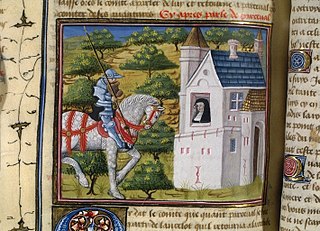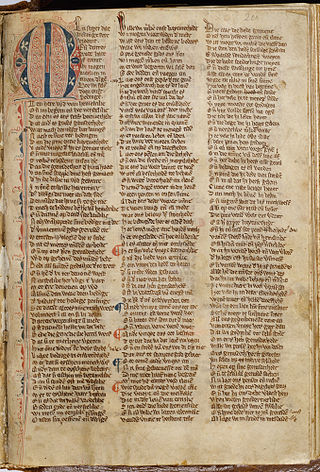Related Research Articles

Gawain, also known in many other forms and spellings, is a character in Arthurian legend, in which he is King Arthur's nephew and one of the premier Knights of the Round Table. The prototype of Gawain is mentioned under the name Gwalchmei in the earliest Welsh sources. He has subsequently appeared in many Arthurian tales in Welsh, Latin, French, English, Scottish, Dutch, German, Spanish, and Italian, notably as the protagonist of the Middle English poem Sir Gawain and the Green Knight. Other works featuring Gawain as their central character include De Ortu Waluuanii, Diu Crône, Ywain and Gawain, Golagros and Gawane, Sir Gawain and the Carle of Carlisle, L'âtre périlleux, La Mule sans frein, La Vengeance Raguidel, Le Chevalier à l'épée, Le Livre d'Artus, The Awntyrs off Arthure, The Greene Knight, and The Weddynge of Syr Gawen and Dame Ragnell.

Chrétien de Troyes was a French poet and trouvère known for his writing on Arthurian subjects such as Gawain, Lancelot, Perceval and the Holy Grail. Chrétien's chivalric romances, including Erec and Enide, Lancelot, Perceval and Yvain, represent some of the best-regarded works of medieval literature. His use of structure, particularly in Yvain, has been seen as a step towards the modern novel.

The Knights of the Round Table are the legendary knights of the fellowship of King Arthur that first appeared in the Matter of Britain literature in the mid-12th century. The Knights are an order dedicated to ensuring the peace of Arthur's kingdom following an early warring period, entrusted in later years to undergo a mystical quest for the Holy Grail. The Round Table at which they meet is a symbol of the equality of its members, who range from sovereign royals to minor nobles.

Percival, alternatively called Peredur, is a figure in the legend of King Arthur, often appearing as one of the Knights of the Round Table. First mentioned by the French author Chrétien de Troyes in the tale Perceval, the Story of the Grail, he is best known for being the original hero in the quest for the Grail, before being replaced in later literature by Galahad.
Red Knight is a title borne by several characters in Arthurian legend.
The Black Knight appears in various forms in Arthurian legend.

The Fisher King is a figure in Arthurian legend, the last in a long line of British kings tasked with guarding the Holy Grail. The Fisher King is both the protector and physical embodiment of his lands, but a wound renders him impotent and his kingdom barren. Unable to walk or ride a horse, he is sometimes depicted as spending his time fishing while he awaits a "chosen one" who can heal him. Versions of the story vary widely, but the Fisher King is typically depicted as being wounded in the groin, legs, or thigh. The healing of these wounds always depends upon the completion of a hero-knight's task.

Gaheris is a Knight of the Round Table in the chivalric romance tradition of Arthurian legend. A nephew of King Arthur, Gaheris is the third son of Arthur's sister or half-sister Morgause and her husband Lot, King of Orkney and Lothian. He is the younger brother of Gawain and Agravain, the older brother of Gareth, and half-brother of Mordred. His figure may have been originally derived from that of a brother of Gawain in the early Welsh tradition, and then later split into a separate character of another brother, today best known as Gareth. German poetry also described him as Gawain's cousin instead of brother.

Parzival is a medieval chivalric romance by the poet and knight Wolfram von Eschenbach in Middle High German. The poem, commonly dated to the first quarter of the 13th century, centers on the Arthurian hero Parzival and his long quest for the Holy Grail following his initial failure to achieve it.

The Lancelot-Grail Cycle, also known as the Vulgate Cycle or the Pseudo-Map Cycle, is an early 13th-century French Arthurian literary cycle consisting of interconnected prose episodes of chivalric romance originally written in Old French. The work of unknown authorship, presenting itself as a chronicle of actual events, retells the legend of King Arthur by focusing on the love affair between Lancelot and Guinevere, the religious quest for the Holy Grail, and the life of Merlin. The highly influential cycle expands on Robert de Boron's "Little Grail Cycle" and the works of Chrétien de Troyes, previously unrelated to each other, by supplementing them with additional details and side stories, as well as lengthy continuations, while tying the entire narrative together into a coherent single tale. Its alternate titles include Philippe Walter's 21st-century edition Le Livre du Graal.
Jessie Laidlay Weston was an English independent scholar, medievalist and folklorist, working mainly on mediaeval Arthurian texts.

Lohengrin is a character in German Arthurian literature. The son of Parzival (Percival), he is a knight of the Holy Grail sent in a boat pulled by swans to rescue a maiden who can never ask his identity. His story, which first appears in Wolfram von Eschenbach's Parzival, is a version of the Knight of the Swan legend known from a variety of medieval sources. Wolfram's story was expanded in two later romances. Richard Wagner's opera Lohengrin of 1848 is based upon the legend.
The Haughty Maiden of Logres is a character from Arthurian legend, appearing in Chrétien de Troyes' Perceval, the Story of the Grail and works based on it. She is left nameless in Chrétien's unfinished romance, but Wolfram von Eschenbach, who reworked the tale for the German epic Parzival, calls her Orgeluse.
Kyot the Provençal is claimed by Wolfram von Eschenbach to have been a Provençal poet who supplied him with the source for his Arthurian romance Parzival. Wolfram may have been referring to the northern French poet Guiot de Provins, but this identification has proven unsatisfactory. The consensus of the vast majority of scholars today is that Kyot was an invention by Wolfram, and that Wolfram's true sources were Chrétien de Troyes' Perceval, the Story of the Grail and his own abundant creativity.

Perceval, the Story of the Grail is the unfinished fifth verse romance by Chrétien de Troyes, written by him in Old French in the late 12th century. Later authors added 54,000 more lines to the original 9,000 in what are known collectively as the Four Continuations, as well as other related texts. Perceval is the earliest recorded account of what was to become the Quest for the Holy Grail but describes only a golden grail in the central scene, does not call it "holy" and treats a lance, appearing at the same time, as equally significant. Besides the eponymous tale of the grail and the young knight Perceval, the poem and its continuations also tell of the adventures of Gawain and some other knights of King Arthur.

Lancelot, the Knight of the Cart, is a 12th-century Old French poem by Chrétien de Troyes, although it is believed that Chrétien did not complete the text himself. It is one of the first stories of the Arthurian legend to feature Lancelot as a prominent character. The narrative tells about the abduction of Queen Guinevere, and is the first text to feature the love affair between Lancelot and Guinevere.

Feirefiz is a character in Wolfram von Eschenbach's Arthurian poem Parzival. He is the half-brother of Parzival, the story's hero. He is the child of their father Gahmuret's first marriage to the Moorish queen Belacane, and equals his brother in knightly ability. Because his father was white and his mother black, Feirefiz's skin consists of black and white patches. His appearance is compared to that of a magpie or a parchment with writing on it, though he is considered very handsome.

In Arthurian legend, Gringolet is Sir Gawain's powerful war horse.
Der Pleier is the pen name of a 13th-century German poet whose real name is unknown. Three of his works survive, all Middle High German romances on Arthurian subjects: Garel, Tandareis und Flordibel, and Meleranz. Little else is known of him, but he was an important figure in the revival of Arthurian literature in Germany in the mid-13th century, after decades of declining interest in the subject.

The Lancelot Compilation is the name given to a Middle Dutch collection, produced ca. 1320, containing seven Arthurian romances folded into the three parts of the Lancelot-Grail cycle.
References
- Brandsma, Frank (2019). "'Al was hi sward, wat scaetde dat?': Emotions and Courtly Cultural Exchange in the Roman van Moriaen". Arthuriana. 29 (4): 28–43. JSTOR 27125914.
- Jonckbloet, Willem Jozef Andries (1870). Geschiedenis der Nederlandsche letterkunde (in Dutch). Vol. 1. Groningen: Wolters. p. 188. OCLC 162926014.
- Lacy, Norris J. (Ed.) (1991). The New Arthurian Encyclopedia. New York: Garland. ISBN 0-8240-4377-4.
- Stufkens, R. (2000). "Moriaen". In Gerritsen, Willem P.; Melle, Anthony G. Van (eds.). A Dictionary of Medieval Heroes: Characters in Medieval Narrative Traditions and Their Afterlife in Literature, Theatre and the Visual Arts. Boydell & Brewer. pp. 184–86. ISBN 9780851157801.
- Weston, Jessie Laidlay (translator). (1901). Morien: A Metrical Romance Rendered into English from the Middle Dutch. London: Nutt.
- Weston, Jessie Laidlay (translator). "Morien". Ancienttexts.org. Retrieved 16 July 2006.
- Wolfram von Eschenbach; Hatto, A. T. (translator) (1980). Parzival. New York: Penguin Books. ISBN 0-14-044361-4.